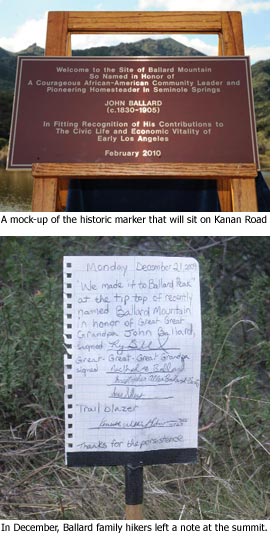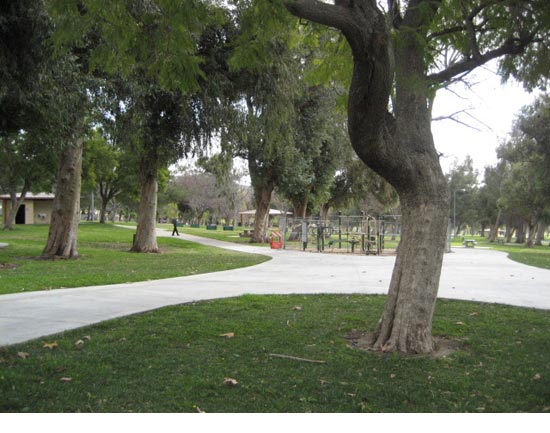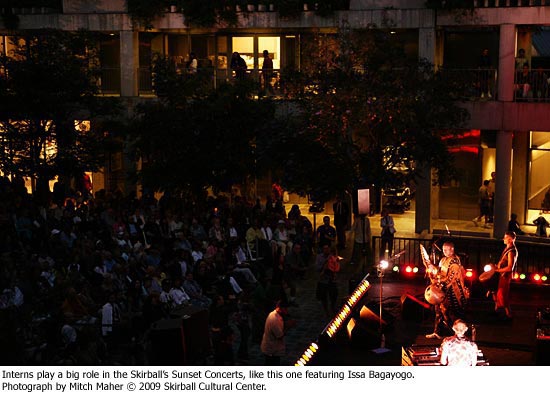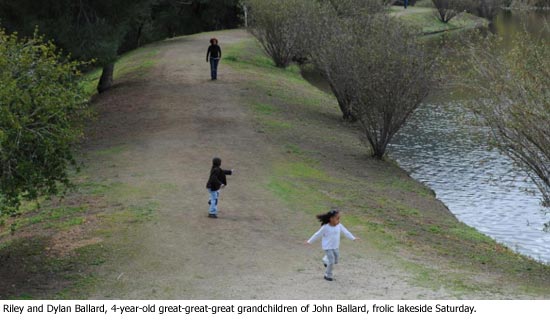Audit released on “alleged intrusion” by Board deputies
February 26, 2010
Following his termination as head of the County’s Department of Regional Planning, former director Bruce McClendon stated publicly that his firing was in retaliation for protesting what he alleged was improper influence over his department by the board and its staff. The county commissioned an independent audit by Harvey M. Rose Associates to investigate McClendon’s charges.
The Rose report examined eight specific allegations, finding five of them “not substantiated” and three “not substantiated, with qualifications.” The full report may be found on the County Auditor-Controller’s site, here.
Posted 2/26/10
Keeping scammers on the run
February 25, 2010
The case may be over, but L.A. County’s real estate fraud investigators are still plenty busy.
Last week, a federal judge sentenced five defendants—including two who drew double-digit prison terms—in a $13 million real-estate fraud case in which the FBI and federal prosecutors received key assistance from investigators of the Real Estate Fraud and Identity Theft unit of the county Department of Consumer Affairs.
Pulling together property and loan records for dozens of fraudulent home-loan transactions, the county investigators “provided invaluable information and assistance” to federal prosecutors, said Thom Mrozek, spokesman for the U.S. Attorney’s Office in Los Angeles.
That assistance helped put Martha Rodriguez, of Downey, and Ed Seung Ok, of Huntington Beach, in prison for 10 and 15 years respectively, following guilty pleas on mail fraud and money laundering charges.
The Silvernet scam, named for Rodriguez’s real-estate firm, ran between 2003 and 2005 and it involved convincing owners of homes in default to sign over their home’s title to a “co-signer” with better credit so they could get a new, bigger mortgage on the house. But instead of giving the new loan to the family, Rodriguez and Ok pocketed most of the proceeds themselves, defrauding the banks and leaving the homeowner with no title, mortgage or right to their home.
Now that the case is over, the fraud unit is beginning to help about 30 victims of the scam pick up the pieces by, among other things, helping the victims negotiate with lenders to regain title of their homes.
“We’re telling people if you are still in this mess, we want to work with you to determine what your best options are,” Acting Consumer Affairs Director Rigo Reyes said. (Click here to learn more about the department’s homeowner services.)
Helping federal prosecutors is a small part of the work of the five-person anti-fraud team, headed by supervising investigator Dawnnesha Smith. In some cases, the investigators resolve complaints through negotiation. In cases that look criminal, investigators refer cases for prosecution to the district or city attorneys’ offices.
Since the collapse of the real-estate market, the sheer volume of complaints has spiked dramatically. “We’re seeing at least double the number of cases since 2007,” up to about 300 real-estate-related complaints each month, Smith said. In addition, the unit recently took over investigations of credit-card theft and other identity fraud.
Hoping to protect the public against scams, Smith said, “we do a lot of work explaining real-estate fraud in speaking engagements.”
The unit’s work is drawing attention from county officials. Reyes and Smith learned Wednesday that the unit won a 2009 SUPERSTARS! Award from the county for “service excellence and organizational effectiveness.” The members are scheduled to be honored at the May 11 meeting of the Board of Supervisors.
The Rodriguez-Ok prosecutions represented the first time the county investigators had teamed up with federal authorities. Since then, they’ve participated in another case, helping federal prosecutors investigate a $1 million real-estate scam in East Los Angeles that resulted in the 2009 conviction of Juan Rangel on charges that he bribed a bank manager so he could stash huge cash payments in his bank account.
Smith’s team is now busy chasing “foreclosure consultants” who prey on homeowners who have defaulted on their mortgages. The scammers charge up-front fees ranging from $1,000 to $10,000 with the promise that they will renegotiate the owner’s mortgage with the bank. Then they’d run off with the money, leaving bewildered homeowners in even deeper trouble than before.
Smith said her investigators have learned of a new scam that exploits public skepticism about banks. “We’ve noticed companies sending out notices saying ‘Your lender is under investigation. Call us to modify your loan’,” Smith said, adding of the new schemes: “It’s ever evolving, and we have to stay ahead of it.”
Posted 2/25/10
Supervisors to consider probation department oversight plan
February 25, 2010
The Los Angeles County Board of Supervisors on Tuesday, March 2, will take up Supervisor Zev Yaroslavsky’s motion to scrutinize the Probation Department’s internal affairs and child-abuse investigations and report back in 90 days with findings. After former Chief Probation Officer Robert Taylor’s retirement and the naming of an interim director until newly appointed CPO Donald H. Blevins assumes his duties in April, Yaroslavsky thought the time was right to borrow the established in-house expertise of the Office of Independent Review to review Probation Department operations. In 2001, the Board created the OIR, today comprising Chief Attorney Mike Gennaco and five other attorneys, to monitor the Sheriff’s Department and investigate allegations of officer misconduct.
Posted 2/25/10
In the fitness zone at El Cariso Park
February 25, 2010
This week, the County’s popular El Cariso Park in Sylmar will have something new to offer its visitors: a new Fitness Zone, an outdoor gym facility made possible through a joint program with the Trust for Public Land, a private non-profit conservation agency that offers seed money and partners with public agencies to promote healthy exercise options in public parks. A total of 21 Fitness Zones have been installed in County parks to date. Fitness Zones help park visitors get and stay fit with easy to use cardio, strength training, and flexibility equipment.
The dedication is set for Thursday, March 4 at 10 a.m.
Posted 2/25/10
A place for kids to chill at the courthouse
February 25, 2010
Court appointments can be stressful for anyone. But kids whose parents have business at the San Fernando Courthouse will soon be able to take the edge off a little in a brand-new Children’s Waiting Room that Supervisor Yaroslavsky, judges and local attorneys will formally open this week.
Kids ranging from toddlers to early teens can enjoy themselves under the watchful supervision of professional child-care providers weekday mornings and afternoons while parents or caregivers do their legal business. The waiting room is the ninth in the County’s court system, made possible through Supervisor Yaroslavsky’s Third District office, the Los Angeles Superior Court, the San Fernando Valley Bar Association and its Attorney Referral Service and the Valley Community Legal Foundation.
The dedication takes place at 10 a.m. Friday, March 5.
Posted 2/25/10
Cue applause for Music Center Bravo Awards
February 25, 2010
 L.A. is widely known as a Mecca for aspiring performers from all over the world, but the region can also field an impressive roster of up-and-coming homegrown talent. Since 1983, as part of the Music Center’s arts outreach and education program, the annual Music Center Bravo Awards, to be held Wednesday, March 3 at the Music Center’s Dorothy Chandler Pavilion, honor distinguished teachers and schools for excellence in the arts. Out of 38 eligible nominees this year, the Music Center will present three BRAVO Awards — one to a general classroom teacher, one to an arts specialist and one to a school – with winners receiving a cash award and a specially commissioned BRAVO sculptured trophy.
L.A. is widely known as a Mecca for aspiring performers from all over the world, but the region can also field an impressive roster of up-and-coming homegrown talent. Since 1983, as part of the Music Center’s arts outreach and education program, the annual Music Center Bravo Awards, to be held Wednesday, March 3 at the Music Center’s Dorothy Chandler Pavilion, honor distinguished teachers and schools for excellence in the arts. Out of 38 eligible nominees this year, the Music Center will present three BRAVO Awards — one to a general classroom teacher, one to an arts specialist and one to a school – with winners receiving a cash award and a specially commissioned BRAVO sculptured trophy.
Posted 2/25/10
Encore for summer arts interns… maybe
February 25, 2010
Here’s what Lisa Dring got out of her arts internship at Circle X Theatre last summer: The chance to produce a reading of a work called “punkplay.” Some grant-writing experience. An associate producer’s credit on the one-man show “Violators Will Be Violated.”
Here’s what else she got: a job.
Dring was one of more than 120 paid interns who worked in Los Angeles arts and cultural institutions last summer, part of a long-running county program that has been targeted for closure due to budget constraints.
Now it looks as if the program—cut from this year’s budget—could get a one-year reprieve.
Under a plan being presented to the Board of Supervisors on March 2, a stripped-down version of the program would put 75 college undergrads to work this summer. The program’s funding would be cut in half—to $250,000, transferred from county reserves—and concessions and contributions would be required from participating arts organizations. The interns would be paid $3,500 for 10 weeks of fulltime work.
“It’s a good thing, and it’s important for the economy right now,” said Arts Commission executive director Laura Zucker. “It’s jobs. Jobs, jobs, jobs…It’s saying ‘We’re not going to stop thinking about the future.’ The creative economy is at the center of Los Angeles’ economy.”
Arts for L.A., a nonprofit arts advocacy organization, is asking former interns and other supporters to write letters and attend Tuesday’s meeting to show their backing for the program.
“It was absolutely amazing. I cannot advocate enough for the program,” said Dring, 22, a recent USC grad who is now on staff at Circle X Theatre as communications director/development associate. She said that she was able to plunge into significant work—“I didn’t get anybody coffee or anything”—almost from the very start of the internship. “I got to do everything.”
“It really helps, no matter what profession someone is going into, to really see firsthand what it takes to create art in this town,” said Circle X’s artistic director, Tim Wright, who has been the company’s intern supervisor for the past 10 years. “I can’t say enough how much the L.A. County arts internship program has meant to us…I’d hate to see it go away.”
“We’ve had an incredible crop of really talented young people,” added Amina Sanchez, associate director of the program department at the Skirball Cultural Center. “They’ve enabled us to present our major summer programs. We can’t do without our interns.”
Laura Katz, a UCLA grad and an intern at the Skirball last summer, worked on its free Sunset Concerts series. She called it “a really great way to get a real work experience,” since it was a fulltime, paid position. Katz, who hopes one day to work as a film music supervisor, said she also enjoyed having contact with world musicians like Issa Bagayogo, from Mali, when they performed at the Skirball.
At Tia Chucha’s Centro Cultural in Sylmar, operations director Trini Rodriguez said it was a dream come true when Stacy Valdez became an intern in the nonprofit’s bookstore last summer. Here was someone who loved books, was in touch with the community and could work with software programs to create business analysis and inventory management reports. “We just had the best fit,” Rodriguez said—such a good fit that when a staff position came open, they offered the job to Valdez. “That’s a good thing—a very good thing actually,” said Valdez, 20, who in addition to working at the bookstore is a student at Mission College.
Zucker said that many of the program’s participants, like Dring and Valdez, stay involved with the arts institutions in some capacity after their internships are up. “A few,” she said, “have become the executive directors over time.”
A Chief Executive Office report recommending restoration of this summer’s program noted that the Arts Commission had previously explored whether it could tap into Temporary Assistance for Needy Families (TANF) welfare funding to keep the program afloat. It found too many limitations on student eligibility, and complications involving compensation, to make that a feasible option. The report said that the long-term objective should be for the Arts Commission to work with local colleges to create an internship-for-credit program.
Posted 2/25/10
No sunny skies for county’s solar grants
February 24, 2010
County officials are scrambling to regroup after the surprise denial of grants they were banking on to help launch a program for homeowners seeking affordable solar and other green-energy retrofits.
Under the program, property owners would repay loans for solar panels and other energy saving devices through an annual assessment on their property tax bills. Once launched, the county’s program would represent the largest of its kind for private property owners in the nation.
There would be no upfront cost to homeowners, who, depending on the extent of the retrofit, could save up to 30% on energy bills. Greater savings were anticipated from a state grant that would have cut interest rates by up to a full percentage point for initial participants.
But the California Energy Commission earlier this month rejected two grant applications from the county—one for $13.5 million to help lower homeowner borrowing costs and the other for $12.9 million to market the program throughout the county’s 88 cities. The commission said the county failed to meet the minimum score required for both applications.
The commission made a $4.7 million grant to the city of Los Angeles, but overall awarded nearly 95% of the available federal funding it administers through the State Energy Program to local governments in Northern California.
“Ultimately, not having these grants makes the program more expensive to property owners in L.A. County and makes it harder for us to promote it,” said Howard Choy, head of L.A. County’s clean-energy division in the Internal Services Department. Instead of taking part in a countywide promotional plan, individual cities will need to come up with ways to advertise the program to homeowners who live outside the county’s unincorporated areas.
The homeowner energy-efficiency loan program, if approved by the Board of Supervisors, is set to begin in August with seed money provided by approximately $12 million in American Recovery and Reinvestment Act (ARRA) funds. Eventually, bonds will be issued and investors repaid as homeowners pay off their retrofit loans.
A typical homeowner of a 2,000 square foot residence might invest $10,000 to $20,000 to upgrade a house by sealing leaks, changing out windows, upgrading the heating and air-conditioning system and purchasing new energy-efficient appliances. Such a whole-house energy retrofit could shave nearly a third off the annual energy bill, and even more if solar-panels are installed to generate additional electricity. (Estimate your home’s potential on the county’s solar map.)
If a homeowner sells the house before repaying the loan, the assessment—along with the improvements—would remain with the property. And that would remove a major reason why some property owners have shunned solar: a concern they’d be unable to recoup their initial investment before selling the property.
Although the California Energy Commission’s rejection of the county’s grants proposals is not fatal, it does present obstacles to getting the program off the ground—particularly by undermining the county’s ability to offer homeowners lower interest rates on energy-saving investments. County officials had hoped to entice public participation through those lower rates, which would have reduced the semi-annual property assessment and shortened the time needed to recoup the initial investment. Overall, the goal is to have the energy projects pay for themselves over the course of 20 years.
Choy said he was shocked by the funding shut-out. “We thought we had a very, very strong application representing a key region,” he said in an interview, noting that the county’s submission was prepared by the same consultants whose grant applications had been approved for other jurisdictions. “We are arranging with the [commission] to discuss the specifics of that scoring in a face-to-face briefing.”
The county’s program is part of a statewide effort formally known as Property Assessed Clean Energy (PACE), created in connection with the sweeping clean energy initiative authorized in 2008 under Assembly Bill 811.
Posted 2/24/10
A family, a dream, a mountain for the ages
February 22, 2010
Every family dreams of leaving something for the next generation. But it’s not often that the legacy includes both a chapter from Los Angeles history and an actual Southern California mountain.
Both have recently come to the Ballard family—and, notably, to the youngest among them: the great-great-great grandchildren of pioneering homesteader John Ballard, whose memory was honored Saturday at a stirring and sometimes emotional ceremony to officially rechristen “Negrohead Mountain” as “Ballard Mountain.”
These members of the Ballard 6.0 generation are the ones who will carry the family line forward and tell its story to future generations. For them, the entire saga stands as both an historical awakening and a highly personal connection to the meaning of family, race and social change across the sweep of time.
Ryan and Nicole Ballard, parents of 4 ½-year-old Dylan and 2-year-old Emile, have been working to incorporate the story of the boys’ great-great-great grandfather into the stories they tell about still-living relatives.
“I think it’s important to know who you are anyway. This is just a tremendous bonus,” Ryan said. “I think that too many young people today do not appreciate history. The president would not be the president today if it wasn’t for history. Even though [Dylan] is a four-year-old, he needs to know.”
One of Dylan’s older cousins, 19-year-old Christopher Ballard, a student at West L.A. College, called his connection to the John Ballard story “kind of an eye-opener.” Almost as if he was realizing it for the first time, he said:
“Oh, I have a long history. A very long history. Part of our family contributed to the history of the state. We have our own landmark now. Now we have our own mountain.”
Christopher, Dylan and a lively cohort of young Ballards were out in force, along with much of the rest of the family, at Saturday’s Agoura Hills festivities, set to formally mark the name change of the peak that, long before it was called “Negrohead Mountain,” went by a version of the name containing a racist epithet.
“We’re thrilled that so many Ballards have come out of the woodwork,” Supervisor Zev Yaroslavsky said to laughter and applause from the audience of about 80. “It was a trickle at first, and then a cascade.”
For the parents in the group, the Ballard saga provides a rich lode of material. “It almost goes without saying that as a mother, you try to look for teachable incidents,” said Ryan’s sister, Rhonda Ballard Sullens. One of the lessons here: “When people work hard for something, you can accomplish something.”
For some of the younger generation, Ballard Mountain is not just name, or a dramatic landmark. It’s a looming physical reality that they’ve actually experienced—and not in an easy way.
In late December, Christopher Ballard joined his cousins Anna Sullens and Nickolas Ballard, his uncle Ryan and other family members in a trek to the mountaintop, led by Kenneth W. Hudnut, a geophysicist with the U.S. Geological Survey.
It was tough going. “There were seven of us at the start. Toward the end, just five…I reached the top,” Christopher said. “It was kind of like that feeling when you have a victory or something.”
 They left a hand-written paper sign up there, something that will go unseen by the thousands who drive by the official Ballard Mountain marker that soon will be placed on Kanan Road. But those who made it to the top will know it is there.
They left a hand-written paper sign up there, something that will go unseen by the thousands who drive by the official Ballard Mountain marker that soon will be placed on Kanan Road. But those who made it to the top will know it is there.
“We made it to Ballard Peak,” it read. “Thanks for the persistence.”
Speakers at Saturday’s ceremony included Yaroslavsky, who took up the cause of the neighbors who initiated the name change crusade, and Marcia McNutt, director of the U.S. Geological Survey, which responded by making the change in “record time.” Also speaking were representatives of First A.M.E. Church, which Ballard helped found in 1869, and two of the neighbors—Nick Noxon and Paul Culberg–who started the campaign to change the mountain’s name. (Read our earlier coverage here.)
Yaroslavsky credited all who had worked toward the new designation with righting “this historical wrong,” and said he took personal joy in the knowledge that the group had been able to “do something for someone who cannot possibly do anything in return.”
Moorpark College history professor Patty Colman talked about hardships that Ballard, who came to Los Angeles in 1859, had had to endure after relocating with his family in the 1880s to the mountain area known today as Seminole Hot Springs.
His cabin was burned out by marauders trying to jump his claim. But Ballard hung tough, Colman said, and posted a sign on the burned-out debris reading “This is the work of the devil.”
Today, she said, “That sign is gone but we’ve got a plaque now.”
Ryan Ballard, speaking on behalf of the family, told the audience that it is impossible to separate African-American history from American history as a whole, and also noted the excitement of finding other possible branches of the family via Facebook and other new connections.
“For us, this is just the beginning,” he said. “We’ve only scratched the surface.”
He also spoke about the life and image of John Ballard, and how they’ve fired the imagination of his living descendants, like Reginald Ballard, Sr., Ryan’s father.
“My father likes to quip about imagining John Ballard standing there in his dungarees and overalls and mis-shaven appearance and saying, ‘I’m not going anywhere,’ ” Ryan told the crowd.
Fifteen-year-old Anna Sullens has spent some time trying to imagine her great-great-great grandfather, too. When she thinks of him, she says, “I think of a man with dignity. An honorable man. Someone people look up to.”
Her 12-year-old brother Ahijah said he is just beginning to get comfortable with his own part in the family story.
“I’m not used to it yet,” he said, “but I’m trying to get used to it.” His middle school classmates at times have been skeptical. “They didn’t believe me because having a mountain, that’s hard to believe.”
But their 13-year-old brother Asa has figured out how to quiet the doubters:
“I just show people a picture of the mountain.”
Posted 2/22/10
For more Ballard Mountain coverage, check out this NBC video clip.



















 Check for the latest closure information
Check for the latest closure information








